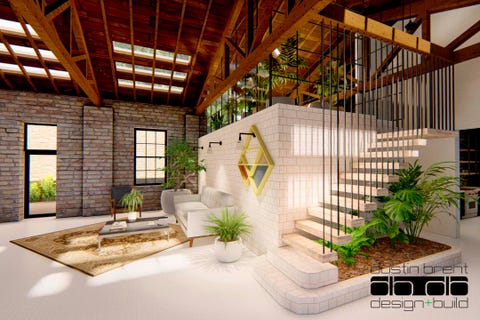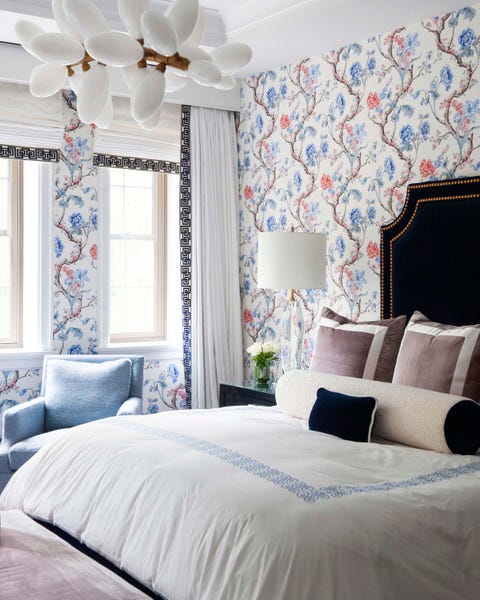Better Homes And Gardens Acadia Outdoor Round Dining Table
It's fair to say we're in the midst of a renovation boom—so Editorial Director Joanna Saltz chatted with experts across the country (including designers, an architect, a contractor, and a builder) to better understand the highs...and lows.
Jo Saltz: I've heard from various sources in the industry that it has never been more expensive to build than right now. Why is that?
Kiley Baun, Shophouse Design: For us in Philadelphia, we have a really huge demand right now, and have for the last few years. It's been increasingly hard to find people to work on your jobs. We've been having a hard time even booking builders a year out. I think there's been more of an interest in design over the last couple years and particularly after COVID.

Dustin Ence, Dustin Brent Design + Build: I'm not 100% sure what's driving it but our home costs for new construction have almost doubled in the last two to three years. We were right around $150 a square foot for new construction and lately we've been at about $300. And it's not because of any one thing that you can easily identify, it's just a little bit in every category. COVID has been a part of that in more than one way: There's a shortage on getting materials, there's a shortage on labor. And here in southern Utah where we've been fairly lucky through COVID, we're getting a lot of people that are coming from cities and towns that have been under much more strenuous lockdown. And so we're busier than ever.
Jessica Pleasants, Godwin Residential Construction and POP Architecture: COVID has definitely had an effect on material prices and the supply chains. So not only is it more expensive to buy things like two by fours, it's also taking longer for people get those supplies. And, to echo what Kiley said, there really is a shortage of skilled labor. The certain experience and hands-on knowledge that's required to do technical work correctly is scarce. I think that's kind of been a generational change. It's hard to get a good plumber, it's hard to get an electrician who knows what they're talking about, and is able to also interact with homeowners who are very personally and emotionally invested in these projects in a way that is respectful of their investment.

Nina Cooke John, Studio Cooke John: That's especially true when it comes to fine custom work, whether it's custom cabinetry, custom metal work, or anything else. You not only need to find people who are good at their trades, but they also need to have good draftspeople who can do good shop drawing so that they can be interpreted correctly. There are many different steps along the chain that ultimately can affect the pricing of that custom handrail. But definitely more recently just getting access to really fine craftspeople has been a big problem.
Jo: It's interesting that southern Utah and New York city are kind of going through the same experience.For those of you who work in both urban and rural areas, are you seeing a surge in one or the other?
Jessica: I think that certainly in the New York metropolitan region, there's been a real exodus to places like Litchfield County, or parts of New Jersey, where maybe people that already had intentions to move out with a small family kind of accelerated that plan, or those with the opportunity to go to secondary house have now made that their primary residence. And that has had a really big effect on the local tradespeople and contractors in these small towns that aren't accustomed to an influx of so many people. In these kind of suburban, or it's called x urban areas, that that translates to greater activity in the design and construction field. And it's even harder now to get those skilled laborers or tradespeople to commit to a project. One local contractor up here has said that he's never been busier in his 18 years of business.

Lisa Russman
Nina: Yes, in Montclair, New Jersey, there have been a lot of people who are buying up really quickly and moving from the city. So we're seeing the same thing here where also because if they had a small apartment in Manhattan, they could sell that and get a decent place here to which they could do a good amount of work right? So they're buying property and then not just moving right in but they they're wanting to do the work on it now before they move in. And it's the same in terms of the local contractors, they're just I just don't think there are enough that are skilled to the level that we would like them to be to work on the projects that we would so we're saying you know look, you might have to wait three months you might have to wait six months.
Jo: So when you all talk about skilled labor I'm curious what it is you are looking for.
Nina: Very often we like to use details that aren't commonly used. So if some contractors are used to doing things in a certain way, and they don't even necessarily really read the drawings that well, they kind of look and they say, "oh, a handrail; I'll make my hand rail," versus contractors who really get into the details and can work with innovative ideas and understand them and know how to bring them about. Apart from that, we want contractors who really plan out the full project way ahead of time. Especially if you're doing apartment renovations, you need to anticipate what the potential problems could be. There any number of things that can come up once you take the walls down, so you need to ask all the really great questions at the beginning of the project. That way, you can be prepared for if and when anything comes up onsite.

Betsy Helm, Shophouse Design: Yes, there are a lot of people who will look at those drawings and then just do their own handrail. We have our tried and true contractors and millworkers, metal workers. And when we can't use those, it's just a wild card like that things go wrong, they go wrong all the time. And we just we'd like to partner with the people that make it as streamlined as possible. And when those people aren't available, it's really hard and honestly, we just push our projects back to get those people to do the job.
Jessica: Speaking from a contractor's perspective, I 100% agree that it is a bit of a wild card when you're working with someone you don't know. That being said, I do think it's really important to keep an open mind when trying to develop new relationships in the field. For every person that has turned out to be a disappointment, you could find your next rock star person. So I think that the vetting process is really important. It's also really important to get competitive pricing for a project. For people that are trying to develop relationships with us, we always we give them an opportunity, assuming one, they have relevant work experience that they can show us and two, that they have references. I wouldn't want any contractor or even designer to think, we're not going to work with anybody new because you have to work with new new people. If you're going to be around for awhile, the person who, say, does your floor stenciling is going to retire and you're not going to have an option—you're going to have to find somebody new.
Dustin: I think we need to advocate for teaching this to our children. There is such a shortage, especially with young people. My subcontractors are telling me their kids aren't interested—whether it's the work ethic or having technology in their hands all the time. And COVID I think exaggerates that since we are in front of screens more and more—we are losing our craftsmanship.

DUSTIN ENCE
Jo: Absolutely. I think we need to spread that message. Our readers are a mix of designers and homeowners, so I want to picot too to those consumer readers: What are the things that you think homeowners constantly overlook during a renovation?
Jessica: I think that a lot of times, homeowners and maybe those that are not guided by design professionals will overlook some finished specifications and things like plumbing fixtures, indoor hardware, thinking that they have plenty of time to decide. But in reality, yes, you might have a lot of time to decide. But the longer it takes for you to figure it out, the more expensive it's going to be from a time perspective and, and the less competitive you're pricing from contractors. So I would always encourage a homeowner, anybody who's going through some sort of home improvement project to spend as much time as they are willing to, or would consider to, to really finalize a lot of those fine details that will play play a big role in getting a project done.
Jo: I think people are constantly surprised at how many decisions have to be made—and probably the biggest value that a designer brings to the table is helping facilitate all those decisions.
Nina: I say along those same lines, decide on things early, but especially with renovations, understand that once construction starts, there very likely will be surprises—especially if you're renovating either an old house.

Dustin: And to add to that, I think this probably happens more on a small level remodel, or maybe a DIY, but engineering is probably never thought of. I think some designers might focus on the design, more than like the reality of things, especially if they haven't been a part of construction. You have to think of the final result that we're trying to get, but also how you're going to get there.
Kiley: Our clients personally don't think about things like the engineer, the lighting specialist, the AV person, the window treatments that are built into the home. Those are all huge price items that aren't really part of the pretty sparkly stuff.
Jessica: Right, and of course not everyone has the budget to hire an AV designer, so where do you find the balance from a design professional standpoint between trying to achieve everything the client wants and working within a budget?
Jo: Absolutely. We always want to consider all budgets. Ok, time for the lightning round. So my last question is: Which do you prefer, a renovation or a new build? And which would you recommend to a homeowner starting a project?

Rachel McGinn
Betsy: I love the challenge and the soul of an existing house. I love seeing what it can be. There are so many existing houses out there on great lots and it kind of reduces our footprint to reuse something that's already there. We love the challenge and kind of listening to the architecture of the home and building upon that.
Nina: I'm biased as an architect, ground up gives me more freedom to really make something to respond very specifically to what that family needs. It does demand someone with a strong will because not everyone is that courageous to just let you go with it but I think ultimately you do get something that's really tailored to you.
Dustin: I think it all depends on the project. For me, it has to be bringing life back into an old, significant building that's either good design or good craftsmanship is awesome, something that's going to be timeless.For me, personally, I would prefer something from the ground up. But I think it has to fit within its natural landscape, whether that's urban or rural—something that's not intrusive.
Kylie: I'm going to cheat and say both. I love a project that has sort of historic renovation. We love that timeless character of these old homes, kind of staying true to what they are, but giving them more modern usage. That being said, I think that that cost is very hard sometimes to control, which is why my answer is that ground up feels a little bit easier, overall, because it's less like piecemeal sometimes. From a design perspective, I would always prefer to do a renovation. from a management perspective, I would always choose to build from ground up.

Jessica: I think a lot of designers and architects would say ground up because it gives you like pretty much no restriction— the sky's the limit in terms of program or aesthetic. But personally if I have a blank canvas, I get catatonic. So I like to work with some sort of existing framework. I agree that, from a design perspective, being unfettered with with existing conditions, is ideal, however, I think given the current situation, if someone was considering a change, I would advise them to do a renovation, because if you've already been living with a space, you are able to kind of live with it for maybe another six months, while you line up all your ducks, and make sure that you have a contractor on board who's going to pay attention to your project, and you have your design specifications squared away, rather than undertaking a new construction with a timeline that might be a little more unruly.
Follow House Beautiful on Instagram.
Hadley Keller Digital Director Hadley Keller is a writer and editor based in New York, covering design, interiors, and culture.
This content is created and maintained by a third party, and imported onto this page to help users provide their email addresses. You may be able to find more information about this and similar content at piano.io
Better Homes And Gardens Acadia Outdoor Round Dining Table
Source: https://www.housebeautiful.com/home-remodeling/a35005766/renovation-issue-round-table/
Posted by: sochahaphe1951.blogspot.com

0 Response to "Better Homes And Gardens Acadia Outdoor Round Dining Table"
Post a Comment